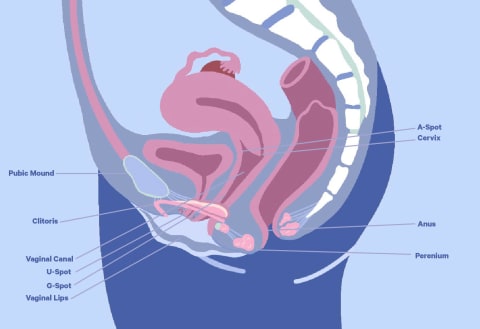“Some studies have suggested sensitivity in this area when stimulated, [which] can lead to improved lubrication and possibly more intense orgasm,” Michael Ingber, M.D., a board-certified female pelvic medicine and sexual health specialist with the Center for Specialized Women’s Health, tells mbg. The A-spot has sometimes been referred to as the “female prostate,” adds Alicia Sinclair, a certified sex educator and CEO of b-Vibe & Le Wand, “because of its precise location and ability to be stimulated similarly to the male prostate.” (The prostate in men is sometimes referred to as the “male G-spot,” interestingly, and typically stimulated anally.) During the study, Chee Ann administered repeated, gentle strokes to the AFE zone to 271 women. About 40% of participants achieved orgasm—not bad considering the awkward circumstance of being sexually stimulated for a research experiment, right? But the more surprising and promising result: A full 78% of the participants experienced increased vaginal lubrication. That’s vital, considering a 2017 study2 found only about 18% of women can reach orgasm from penetration alone. It can feel good, but without catering to the clitoris, sex can feel like dinner without dessert—filling, but not as sweet as it could be. Today, the scientific community is still at odds about whether there are actually any sort of special, highly sensitive spots within the anatomy of vagina owners other than the clitoris. Medically speaking, research on the G-spot’s existence3 is conflicting and inconclusive, and experts argue about whether the vagina even has more concentrations of nerve tissue in particular areas over others, throwing the idea of G-spots and A-spots and any other spots into question. To complicate things further, “It is unknown if, in many women, the A-spot is really the G-spot, just located a bit deeper inside than others,” Ingber explains. The fact that there’s still so much mystery around the primary female pleasure organs is less a reflection on the complexity of the female body and much more a reflection of how little research, time, money, and energy has been invested into understanding female pleasure. But in the meantime, whether these spots are actually unique anatomical entities all their own or simply areas close enough to the inner shaft or wings of the clitoris to stimulate it, there’s at least some evidence suggesting women can explore these areas as at least potential places to access pleasure. When followed correctly, these instructions will lead you to hit the spongy tissue where the G-spot is believed to be located, and 1 to 2 inches inward from there is the A-spot. In order to stimulate the spot, move your fingers or have someone else move their fingers over the tissue in a windshield wiper motion. The key is to blend both movement and light pressure. Anal sex may also be a good way to reach this deeper spot: “Anal orgasms can also happen through indirect stimulation of the erogenous zones within the vagina,” Sinclair says. Whether or not the A-spot is its own unique vaginal erogenous zone, if finding and stimulating this spot could intensify orgasms and provide a little more slip during sex, why not give it a try? And one other added bonus: Pleasure through the A-spot can take place in encounters outside of just P-in-V sex. That makes it an extremely accessible and fresh means for exploration.




